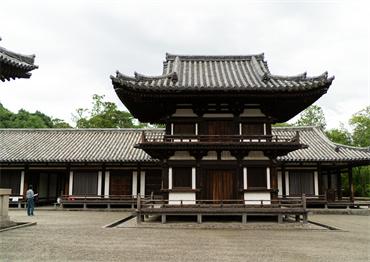Over the following decades, Jianzhen traveled extensively in Yangzhou and beyond to propagate Buddhism, delivering lectures on the precepts of the Buddhist faith to more than 40,000 disciples. His reputation grew, and he became known as a Dharma master of Buddhism.
The Tang Dynasty is considered a pinnacle of Chinese civilization. Its capital Chang’an, today’s Xi’an in Northwest China’s Shaanxi Province, was the most advanced and the largest city in the world, attracting tens of thousands of people from far and wide to admire its splendor and conduct trade.
The Japanese court frequently dispatched delegations of government officials, scholars, Buddhist monks, doctors, craftsmen and technicians – the elites of Japanese society. They were royal ambassadors who embarked on hazardous sea voyages to learn from China for the benefit of Japan.
One important aspect of the missions was to learn more about Buddhism, as some inaccurate doctrines and practices of Buddhism had become prevalent in Japan. Many selfprofessed monks were laymen in disguise because of the privileges and reverence accorded to monks, such as tax and military service exemptions.
Many ambassadors would remain in China for long periods, traveling widely to learn the correct Buddhist teachings from venerated Dharma masters. By royal command, they invited the most eminent and dedicated Chinese Dharma masters to travel to Japan to help re-establish the correct precepts and practices of Buddhism.
Yoei and Fusho, two of the most revered monks among the Japanese emissaries, were tasked with such a mission in 733. After serving in several temples in China, they traveled extensively in search of a Chinese Dharma master to return with them.
A Chinese monk named Daohang suggested the respected Dharma master Jianzhen. Daohang had been a disciple of Jianzhen, and in 742, he accompanied Yoei and Fusho to Yangzhou to seek Jianzhen’s help.
When Jianzhen learned about the mission, he gathered many of his former disciples who had become successful monks in temples in and around Yangzhou, to meet them. The story goes that Jianzhen asked for volunteers to undertake this challenging but worthwhile mission. After a prolonged silence, they declined one by one for fear of perishing at sea.
After recounting the story of Prince Nagaya donating 1,000 kasayas to Chinese monks and reciting the poem embroidered on the robes, Jianzhen decided he would go to Japan. Moved by their master’s bravery and conviction, 20 of his former disciples changed their minds and followed him.
Jianzhen, then 55, and his followers set sail for Japan the following year. But the mission did not make it that year, or the next. In the 11 years from 743 to 754, they made five failed attempts because of unfavorable weather, legal complications and other setbacks. Finally, Jianzhen succeeded on his sixth attempt in 754. By then, he was 66, had lost his eyesight due to disease, and Yoei, one of the two Japanese monks who recruited him, had died the year before.

 Old Version
Old Version



